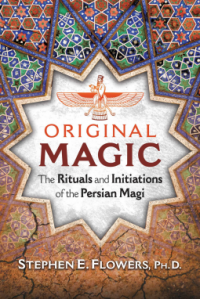Currently reading
Original Magic

by Stephen E. Flowers, Ph.D
This book claims to reveal for the first time the origins of the study of magic, specifically Zoroastrianism. This origin comes from Ancient Persia, now Iran, the etymology given as Mazdan -> Magian -> Magician.
The author asserts that his intention is that Western students of magic will use this information as a basis to further explore their own methods, but with knowledge of a 4000 year old history that forms the basis of much of what has been filtered through many cultural influences over that time to develop into modern magic as we know it.
There are five chapters followed by seven appendices. The first chapter is entitled It's Time to Life the Ban and is about the basic training system for a Mazdan and the knowledge they are to accrue over a twelve month period. The chapter explains the significance of an initiatory path and defines terms for the purposes of the book, explaining the difference between magic and sorcery as well as various cultural terms. I really enjoyed reading about history of this culture from a philosophical perspective rather than a political one.
The second chapter goes into more detail about the history of Iranian magic. The ideas of Zarathustra (called Zoroaster by the Greeks) and the progression of religion all the way up to current Muslim prevalence in Iran is covered as well as the idea of magic as religion.
Chapter three is called Theories of Mazdan Magic. Here we go into cultural ideas of duality and cosmology that look rather a lot like the roots of Judeo-Christian religious structure and morality, but with Astrology providing a cosmological model. Then chapter four brings us to Initiation to Magic. The author emphasises the importance of initiation and lays out a twelve month process for accomplishing a self-initiation according to Mazdan practices. Here it is easy to see the basis for many systems of elaborate daily ritual using specific ritual equipment.
As a historical record, this is brilliant. The exercises themselves present a solid structure of discipline, but is culturally based in a basically monotheistic religion that is the basic for the Abrahamic religions. I can't imagine that Western practitioners would benefit much from reciting the formulae in the Avestan language. It's a strong academic work that would be of value in the reference library of anyone interested in the history and study of magic on a spiritual level.
The fifth chapter is on Rituals of Mazdan Magic. The author starts by stressing importance of using original languages for manthras and of both inside and outside environments for performing the rituals. These rituals are very ceremonial and steeped into the belief system of the Persian Mazdan.
After these chapters we have seven appendices. The first is a brief history of Eranshahr, which is basically cultural background for the beliefs and practices of what this book is about. In just a few pages, the author explains several hundred years of Middle Eastern peoples, migrations and empires in a straightforward narrative that I personally found fascinating, as someone who has an interest in history.
Appedix B is a pronunciation guide for the Avestan language, then Appendix C details the Three Major Avestan Manthras. Appendix D lists 101 names of God to be used in the manthras, then Appendix E explains basic Mazdan astrological lore. Appendix F is resources; addresses online to find further information.
The Appendices are followed by a glossary, notes, then a bibliography and reading list, and of course an index.
I found the book historically fascinating, though the belief system involved doesn't fit with my own beliefs. It is certainly well-researched and a gem of a historical record. A very interesting read.
 1
1





